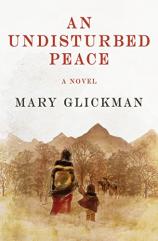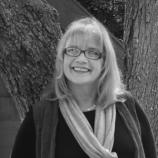Author Talk: February 1, 2016
Mary Glickman is the author of HOME IN THE MORNING; ONE MORE RIVER, a National Jewish Book Award Finalist in Fiction; and MARCHING TO ZION. Her latest book, AN UNDISTURBED PEACE, follows a trio of outsiders --- linked by unrequited and rekindled love --- as they find themselves surrounded by the escalating horrors of President Andrew Jackson’s Indian Removal Act. Here, Mary discusses creating compelling characters, why she loves writing about outsiders, and her odd preference for writing from a male perspective.
Question: In historical fiction it would appear that the author must both make her characters relatable to contemporary readers and historically authentic. When creating characters and dialogue, how do you strike the balance of staying true to the time period and connecting with a modern audience?
Mary Glickman: As the saying goes, times may change but people never do. I find it most useful to engage the reader on the historic level through setting and event, using language in dialogue that is tinted with period flavor while avoiding the anachronistic. As for engaging them on a modern level --- the human heart will always struggle with the same passions, desires, flaws and virtues of character. These elements are immemorial and I have confidence that the modern reader will recognize him/herself in their portrayal.
Q: In your Author’s Note, you say that by creating an accurate vision of everyday activities and social habits, an author brings the historical novel to life, all the while ensuring that “she has not violated the honor of an ethnicity not her own.” How does your process of character creation differ when creating a person who is outside your ethnicity?
MG: First of all, there must be research! Those everyday activities and social habits inform character in every ethnicity. But, in a way, they are cues only. Just as I point out above, comprehending the universality of human experience is key in expressing historical character and dialogue. Different ethnicities may express human frailties and human strengths through different cultural portals, but those frailties and strengths are the same for everyone. Which human qualities a particular ethnicity has come to emphasize through its culture can depend on historic experience. A warrior culture, for example, will prize bravery and stoicism. A merchant culture will prize prudence and economy.
Often in AN UNDISTURBED PEACE, Abe notes cultural similarities between Jews and Cherokees, but these instances are diverse in genesis. Such points of diversity are where the author must be especially sensitive.
Q: Abrahan, Jacob and Dark Water all seem to have something in common: They’re outsiders in their communities. Jacob relates more to the Cherokee than his fellow slaves, Dark Water leaves her people to live in the mountains, and Abrahan was forced to leave London because of a stigma against Jews. What attracts you to writing about outsiders?
MG: Easy! I am one! First from birth, as the middle child of a large family. Second, as a creative in my growing up and student years. Third, as a converted Jew. Fourth, as a creative my entire adulthood. Hardly anyone understands artists. Often, not even other artists. We’re all such queerly independent thinkers. Specifically, as a writer, I find it’s important to be outside looking in, ever the quiet observer, even when I’m being noisy. And if you get that, you’re probably an outsider, too.
Q: Why did you choose to use Abrahan as the window onto this tragedy as opposed to Dark Water?
MG: I enjoy writing from the male perspective. I couldn’t tell you why. In the past, I’ve taken my own attitudes and perceptions as a female and injected them into a male character. I was told later by readers that they fell in love with him, that he was the most attractive male character they’d ever read. That gave me a chuckle.
In AN UNDISTURBED PEACE, I wanted Dark Water to possess a larger-than-life quality without making her a New Age cartoon. To achieve that I needed a measure of narrative distance from her, a reverence, perhaps, which is why we see her largely through Abe’s eyes.
The Cherokee woman was uniquely empowered before the European invasion. When the Europeans first negotiated treaties with the Cherokee, they were astounded that women were involved in the negotiations as members of the General Council. The Cherokee were astounded that the Europeans brought no female negotiators with them. Eventually, that feminine role became somewhat degraded through European cultural dominance. This was a tragedy, of course, and tragic heroes like Dark Water are at narrative risk in our cynical age of becoming maudlin. I found that keeping her at a distance lent her a mythos that would prevent such diminishment.
Q: What is your relationship with the characters you have created, both while you are in the process of writing and once you have finished a novel?
MG: This is one of those questions that flummox me a little. I know many authors claim to have a kind of mystical relationship with their characters, but I simply do not. My relationship with them is one of creator and created. They do not have free will except that I cannot make them do anything that is outside their created nature, or they become artificial. So my goal is to make them authentic. If they are authentic, then the reader will be enthralled. If they are not, the reader will be either irritated or bored. Sometimes, an author must battle biases readers bring to the table, and anticipating those biases is part of the creation process.
That being said, I do tend to be fond of my creations, even the villains. Since while I am occupied with their creation, I eat, sleep, dream, and think of them intensely, they linger in my mind when I’m done writing the piece. But that fades over time.
Q: For those interested in learning more about the plight of Dark Water and her people during the Trail of Tears, what resources do you recommend?
MG: The sources cited in this guide and in my Author’s Note are excellent! If one is strongly interested in the Cherokee, nothing beats a trip to Cherokee, North Carolina or to Oklahoma City for the Cherokee museums and Native American centers there.









